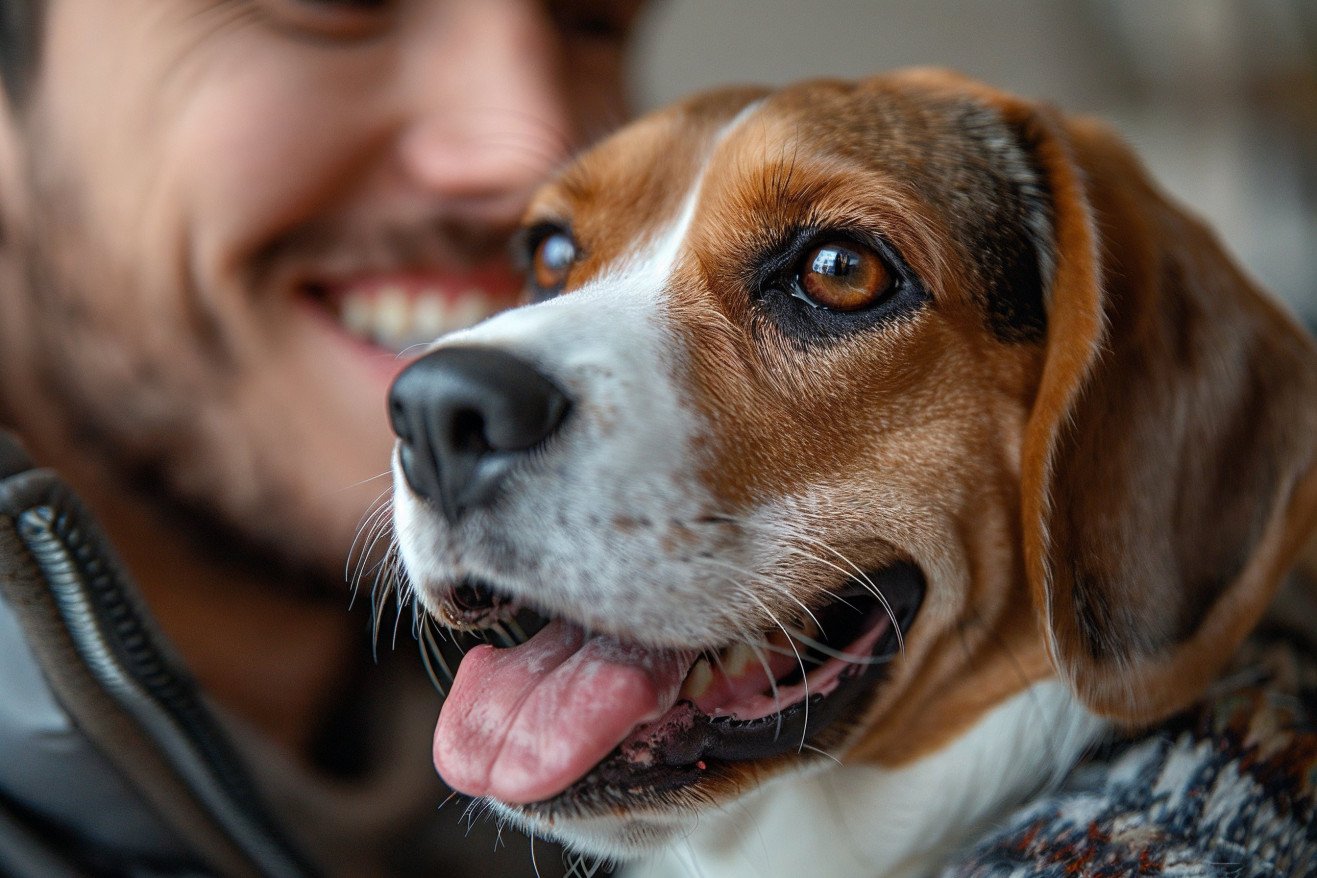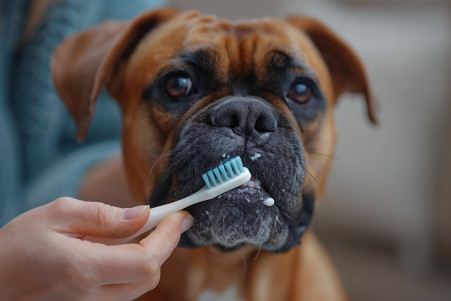Is It True That a Dog’s Mouth Is Cleaner Than a Human’s?
29 February 2024 • Updated 29 February 2024

The old saying says that a dog’s mouth is cleaner than a human’s, but is there any truth to this? The reality is that a dog’s mouth is not cleaner than a human’s mouth. Both are home to a wide variety of bacteria, some of which can be harmful.
While dog saliva does have some antibacterial properties, it can also spread infections, making the idea of “cleaner” a matter of perspective and a bit of a misnomer.
This article covers a range of scientific viewpoints on the topic, including veterinary research, microbiological studies, and perspectives from dental professionals. In these inquiries, researchers investigate the makeup and impact of the bacteria that live in the oral microbiomes of dogs and humans. By integrating information from different scientific fields, we aim to offer a well-rounded view of the myth of canine oral cleanliness and its implications for human well-being.
Is a dog's mouth cleaner than a human's?
The Oral Microbiota of Dogs vs. Humans
One article in Animals delves into the oral microbiota of dogs and identifies a core oral microbiota of 67 bacterial species, with Bacteroidota, Proteobacteria, Actinobacteriota, Desulfobacterota, and Firmicutes as the most abundant phyla. Meanwhile, another article in PLoS ONE underscores the unique bacterial composition of dogs, finding that only 16.4% of oral taxa are shared between dogs and humans, indicating a major difference between the oral microbiomes of the two species.
The implications for health are many. While some bacteria are commensal or even beneficial in the oral microbiome, others have been linked to systemic diseases, including cancer, as a review in Animals explains.
For example, some studies have found that certain bacteria in the human oral microbiome are associated with oral cancer, suggesting that the bacteria in the oral microbiome of dogs may have similar health effects, although more research is needed to confirm this.
As a result, the claim that dogs’ mouths are cleaner than humans’ is not supported by science. The large and varied bacterial communities in each species indicate complex oral ecosystems that can’t be labeled as ‘cleaner’ or ‘less clean’ based on the presence of bacteria. This complexity is important to understand before we move on to the interesting topic of dog saliva and its impact on human healing.
Dog Saliva and Wound Healing
Is it OK to let a dog lick a wound? This is a question that has puzzled pet owners for generations. While dog saliva has been shown to have antibacterial properties that are effective against certain bacteria, including Escherichia coli and Streptococcus canis, a study published in PubMed shows that it is not universally protective. In fact, letting a dog lick a wound can introduce other bacteria and make the wound worse.
According to The Kennel Club, the natural instinct of dogs to lick wounds can lead to irritation, delayed healing, and in the worst-case scenario, infection. This is especially worrisome when you consider the risk of serious infections like Capnocytophaga canimorsus, which can be transmitted through dog saliva and, according to a study published in PMC, can lead to life-threatening sepsis.
To avoid the risk of complications, it is best to keep dogs away from wounds and not let them lick them. While the antibacterial properties of saliva may be helpful in some cases, the potential risks, especially for people with weakened immune systems, make it not worth it. Instead, wound care should include medical intervention and treatment, which is much more helpful than the well-meaning but potentially dangerous licks of our furry friends.
Why Dog Dental Health Is So Important
Dog dental health is about more than just keeping your pet’s breath smelling fresh; it’s also about keeping them healthy. In fact, according to the Cornell University College of Veterinary Medicine, 80–90% of dogs over the age of three have periodontal disease, which is one of the main sources of bacteria in a dog’s mouth.
It’s important to manage this bacteria to prevent disease, and that means regular dental care and treatments like brushing with dog toothpaste and dental chews, according to PetMD.
If left untreated, poor dental health can lead to systemic infections and heart disease, according to the American Kennel Club. However, pet parents can help prevent these issues by following best practices for dog dental health, including daily brushing, regular vet cleanings, and feeding their pets special dental diets.
Not only does proper dental hygiene help prevent bad breath and disease, but it also helps keep a dog’s mouth clean in comparison to a human’s. While maintaining good oral hygiene can help ensure a dog’s mouth is cleaner, it doesn’t necessarily mean that a dog’s mouth is cleaner than a human’s. Instead, it shows that good oral hygiene is important for any mouth, whether it’s human or canine.
Myths About Canine Oral Hygiene
Another myth that has been perpetuated for years is that a dog’s mouth is cleaner than a human’s. So, is there any truth to this claim? According to PetMD, there are about 700 different types of bacteria in both the human and canine mouth, but the bacteria in each species is different.
In addition, the American Kennel Club explains that a dog’s mouth is not necessarily safer for humans because some bacteria in a dog’s mouth, such as Pasteurella canis, can cause skin infections, and Capnocytophaga canimorsus can cause severe infections, especially in people with weakened immune systems.
These studies show that a dog’s saliva is not sterile and that it’s not true that humans are unlikely to get sick from most of the bacteria in a dog’s mouth. In fact, according to Veterinary Dental Services, while most bacteria in a dog’s mouth are not zoonotic, or transmissible to humans, people should still be cautious, especially if a dog is fed a raw diet, which can increase the risk of salmonella.
There are also differences in the way humans and dogs practice oral hygiene. For example, dogs need special toothpaste and regular dental cleanings to maintain their oral health. These differences in oral hygiene practices between the two species have led to the myth that a dog’s mouth is cleaner.
However, based on these studies and expert opinions, it’s clear that this myth is not true. Instead, both humans and dogs need to practice good oral hygiene to keep harmful bacteria at bay.
The Verdict: Canine vs. Human Dental Health
In conclusion, the evidence presented has clearly debunked the long-standing myth that a dog’s mouth is cleaner than a human’s. The many scientific studies discussed in this article have shown that this common belief is not true.
From the differences in the bacterial makeup of dogs and humans, as noted by the American Kennel Club, to the potential dangers and limited benefits of letting dogs lick human wounds, we have seen that the truth is far more complicated.
Both dogs and humans have a variety of bacteria in their mouths, and while not all of these bacteria can be passed from one species to another, the potential for the transmission of disease is real, especially when it comes to bacteria like salmonella and Pasteurella. That said, it’s important to maintain good dental hygiene to minimize these risks and promote the overall health and well-being of both humans and their dogs.
Given this, it’s important to let science inform our understanding of dental health. The comparison of canine and human dental health should be based on evidence rather than myths. So enjoy your relationship with your dog, but do so with the understanding and accountability that comes with knowing the truth about the world we share.


